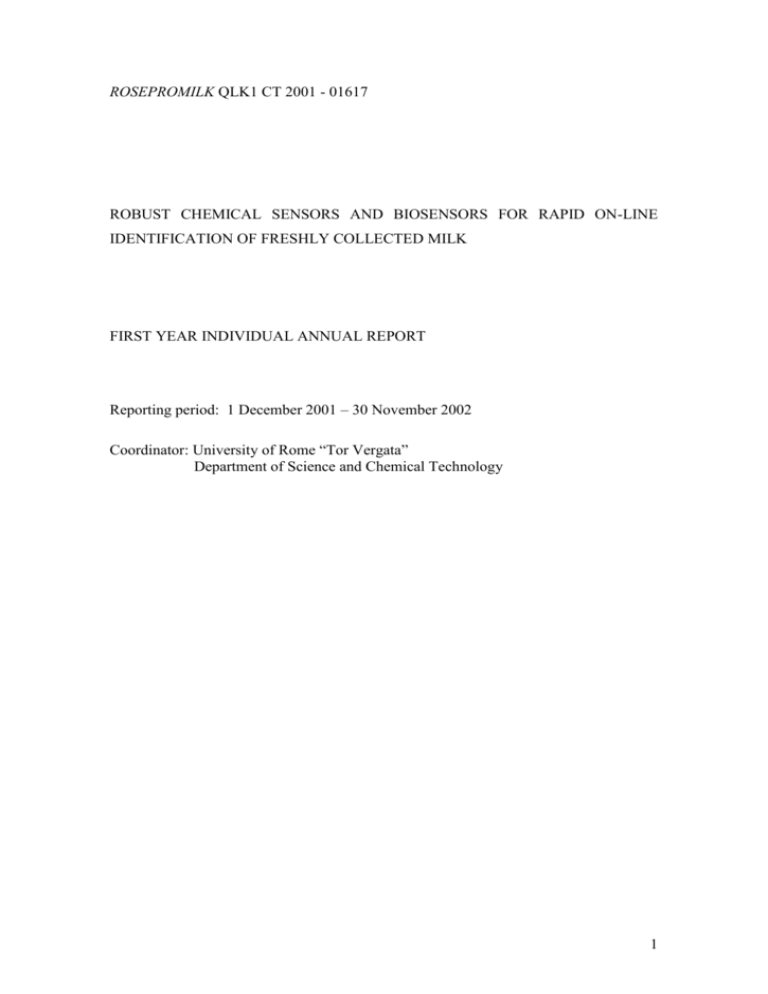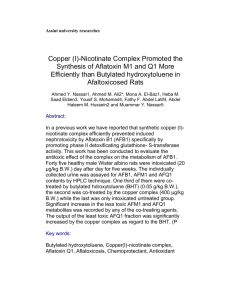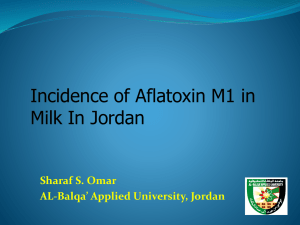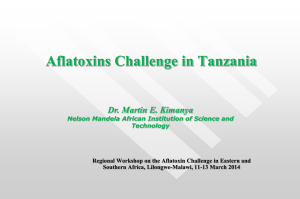first year individual annual report - Università degli Studi di Roma
advertisement

ROSEPROMILK QLK1 CT 2001 - 01617 ROBUST CHEMICAL SENSORS AND BIOSENSORS FOR RAPID ON-LINE IDENTIFICATION OF FRESHLY COLLECTED MILK FIRST YEAR INDIVIDUAL ANNUAL REPORT Reporting period: 1 December 2001 – 30 November 2002 Coordinator: University of Rome “Tor Vergata” Department of Science and Chemical Technology 1 1. Objectives and Expected Achievements Mycotoxin contamination Milk is susceptible to contamination from external sources; one key analyte is aflatoxin M1 (CRM). Aflatoxin M1 is a hepatocarcinogenic mycotoxin, that could occur in milk of cows fed with aflatoxin B1- contaminated feedstuffs. It is proposed to develop a sensor for aflatoxin M1. The procedure we have to develop is totally innovative consisting in the development of an electrochemical procedure, which allows a sensitive detection of Aflatoxin M1 directly on a probe surface using commercially available antibodies to aflatoxin M1. This procedure requires simple steps, can be carried out directly in the milking parlour with the use of inexpensive instrumentation, also the probes are strips which will be disposable to avoid problems with probe regeneration and calibration. Expected achievements 1. Immunosensor for Aflatoxin M1. 2. Laboratory validation for faecal contamination and Aflatoxin M1 detection. 3. Integration of (i) and (ii) into robotic milking machine. 4. Validation of (iv) in operational milking parlour. 2 ROSEPROMILK FIRST ANNUAL REPORT ROLE OF PARTICIPANTS: Participant n. 2. University of Roma “Tor Vergata”. Dipartimento di Scienze e Tecnologie Chimiche Team Leader: Prof. Giseppe Palleschi Scientist involved in the project: Prof. Danila Moscone Dr Laura Micheli Objectives Immunodetection for aflatoxin M1 Work plan Task 2.1 Development of an immunosensor for Aflatoxin Subtask 2.1.1. (Months 0-6) The first step will be the conjugation of commercially available antibodies anti-aflatoxin with appropriate enzymes, as alkaline phosphate or peroxidase or other label enzyme compatible with the immunoanalysis with milk matrix. Also aflatoxin itself will be conjugated with enzyme. Subtask 2.1.2. (Months 6-12) Direst ELISA competition tests or ELISA sequential analysis will be carried out using spectrophotometric detection. Buffer, temperature, pH will be selected to obtain the best signal/noise ratio. Subtask 2.1.3 (Months 12-18) Study of selectivity, interference, cross-reaction and stability of the conjugate will be carried out and the lower and upper detection limits defined. Aflatoxin determination using standard solution and ELISA with spectrophotometric detection will be carried out. Task 2.2 Screen printed electrode evaluation Subtask 2.2.2 (Months 18-21) After the selection of the best electrochemical transducer, conjugated enzyme-toxins or enzyme antibody will be fixed on the electrode strip using immobilisation procedures in which almost all participants are expert. Subtask 2.2.3 (Months 21-24) Then ELISA procedures (direct or sequential) will be performed according with well know protocols. Also the optimisation of the analytical parameter will be carried out and the results obtained with the electrochemical procedure in standard solutions of aflatoxin will be compared with those obtained spectrophotometrically. 3 Deliverables !!!!!!!!!!!!!!!!!!!!!!!!! Research activities during the first reporting period TASK 2.1 Development of an immunosensor for aflatoxin Immunosensors are analytical devices, which selectively detect analytes and provide a concentration - dependent signal. Electrochemical immunosensors employed either antibodies or their complementary binding partners (antigens) as biorecognition elements in combination with electrochemical transducers. Immunoassay techniques are based on the ability of the antibodies to form complexes with corresponding antigens. The property of highly specific molecular recognition of antigens by antibodies leads to highly selective assays based on immune principles. The extreme affinity of antigen-antibody interactions results also in a great sensitivity of immunoassay methods. The most common type of immunoassay is known as enzyme linked immunosorbent assay or ELISA. This method is a conventional solid phase immunoassay technique, where the antigen-antibody interaction occurs at a solid phase surface. The first task of this work concerns the study of an electrochemical immunosensor for the determination of AFM in milk using “screen printed electrodes”. Subtask 2.1.1 months: 0-6 Person months: !!!!!!!!!!!!!!! The first step of this work has been the evaluation of commercial AFM1 labelled with Peroxidase (AFM1-HRP). This product was purchased by R-Biopharm (Ridascreen kit - Germany) and was used for testing the affinity and the quality of the disposable antibody against AFM1. With this conjugate, a direct ELISA competition test with spectrophotometric and electrochemical detections has been developed, then results obtained with the two procedures have been compared. Subtask 2.1.2: months 6-12 Person months: !!!!!!!!!!!!! 4 The development of spectrophotometric ELISA for AFM1 before the electrochemical study allowed the definition of the working ranges, limit of detection and the characteristic of the immunological reagents (antigen and antibody) prior the additional testing with the electrode. The test was performed in a 96-well microplate according with a direct ELISA format. This kind of test was based on a competition between antigens labelled (added) with enzyme and unlabelled (sample or standard) for binding sites of antibodies, immobilised on the preactivated support (scheme A). The preactivation consists of a preimmobilisation of antibodies anti-IgG (mouse) for improvement the amount and the orientation of the antibodies specific for the analyte to be analysed. The amount of labels associated with the solid phase is inversely related to the concentration of antigen. Ab IMMOBILISATION PRECOATING PRECOATING E AFM1 and AFM1-enzyme ADDITION DETECTION E Anti-IgG (mouse) Solid Support Monoclonal Primary Ab Enzyme-antigen conjugate S P Antigen Assay optimisation For improvement the amount and the orientation of the primary antibodies (antiAFM1), the study of a preimmobilisation of antibody against anti-IgG has been carried out. Fig. 1 shows the precoating results and it is possible to observe that the better working conditions were obtained when a precoating step with 10 µg/mL of anti-IgG in 100 mM carbonate buffer pH 9.6 was carried out. 5 PRECOATING 350 Fig. 1. Precoating study ABS @ (655 nm) 300 250 coating, blocking, AFM1-HRP NO PRECOATING 200 precoating, coating, blocking and AFM1-HRP 150 100 black: no coating, only blocking and AFM1-HRP 50 0 0 1 2 3 4 5 The study of the buffer (carbonate and phosphate saline buffers), the time (overnight, 2 h), and the concentration (0.3 – 40 µg/mL) for the coating step had been carried out. Results showed that a good immobilisation was achieved when the coating step was carried out for 2 h at 37°C, with a solution of 5 µg/mL of primary monoclonal antibody (anti-AFM1) in PBS (fig. 2, 3, 4). We have chosen 2 h for the coating incubation time because the results were comparable with those obtained with overnight incubation time, but shorter. PBS 350 ABS@ (655nm) 300 250 Fig. 2. Coating Buffer Study CB 200 CB = 100 mM carbonate buffer pH 9.6 PBS = phosphate saline buffer pH 7.4 150 100 50 0 160 ABS@ (655nm) 2h OVERNIGHT 140 2 h 120 100 Fig. 3. Coating Time Study overnight black: no coating, only blocking and AFM1-HRP 2 h black: no coating, only blocking and AFM1-HRP 80 60 40 20 0 0 1 2 3 4 5 6 Coating Curve ABS @ 655 nm 0,25 0,20 Fig. 4. Coating Curve 0,15 Black: no coating 0,10 Blank 0,05 1 10 [MAb] µg/mL The binding study was carried out adding several dilutions of AFM1–HRP conjugate into the microtiter plate. The 80% of the curve answer supplies the labelled antigen to use in the competition study to have the maximal sensitivity and the 1:30 v/v dilution of this was chosen (fig. 5). The competition study was carried out in two ways: in one where free and labelled AFM1 were mixed together directly on the support where the specific antibody was immobilised, while, in the second case, different dilutions of free toxin were added on the support before the addition of the labelled antigen. In this second case we tried to promote the binding of the AFM1 with its antibody to increase the sensitivity of the analysis. Different intervals (10, 30, 60 min) of the incubation time of the free antigen were studied and better results were archived when the antigen was added 10 min before the labelled AFM1 (data not showed). In both cases the total time of the competition step was 2 h. Standard curves were obtained using AFM1 standard solutions prepared in PBS (0 – 480 pg/mL) for spectrophotometric ELISA. Calibration curves (absorbance at 655 nm vs. competitor concentration) were fitted using “non-linear 4 parameter logistic calibration plots” [i]. The four parameter logistic function is: f(x) = [a – d]/ [1 + (x/c)b] + d. The parameter a and d are the asymptotic maximum and minimum values, respectively; c is the value at the inflection point (IC50) and b is the slope. 7 To allow a direct comparison of some calibration curves, absorbance values were converted into their corresponding test inhibition values (% A/A0) as follows: % A/A0 = 100 x (A - Asat)/(A0 – Asat) where A is the absorbance value of competitors, Asat and A0 are the absorbance values corresponding to the saturating analyte and to the non-competition concentration respectively (as evaluated by the four-parameter logistic function). The detection limit was defined as the concentration of AFM1 equivalent to the three times the value of the standard deviations (s) measured in the absence of AFM1 (mean value – 3 s). The midpoint value (IC50) was evaluated as the concentration of AFM1 at 50% A/A0. The working range was evaluated as the toxin concentration that gives test inhibition values of 90 % and 10% of A/A0. The data obtained for each curve were plotted and fitted using a SigmaPlot software (SPSS). Regression analysis on the linear portion of the sigmoidal curves was also performed. Results showed different working ranges: - in the first case, the working range was 0.2 – 7.4 ng/mL (ppb); - in the second case, with a free AFM1 incubation time, was 30 -160 pg/mL (ppt). Only in the second case the maximal level (50 ppt) of AFM1 was detectable. Then we report the optimised final protocol of spectrophotometric competitive ELISA: the wells were coated with 200 µL of 10 µg/mL of Anti-IgG (mouse) solution in 100mM carbonate buffer pH 9.6 overnight at 4°C. After rising with 250 µL of PBS-T (PBS + 0.01% Tween 20), the wells were incubated with 100 µL of primary antibody (5 µg/mL of monoclonal anti-AFM1 in PBS). After washing, the competition step was carried out as follow: several AFM1 standard solution were let to react into the wells for 10 min and then mixed with the AFM1-HRP conjugate at constant concentration (1:15 v/v). The competition reaction was allowed to proceed for 2 h at room temperature at dark. The microtiter plate was, then, rinsed with PBS-T and, finally the chromogen/substrate solution was added to the wells and the enzymatic reaction was stopped after 30 min at room temperature. Absorbance was read at 655 nm. 8 120 100 % A/A0 % A/A 0 Current (µA) 80 Current (µA) 80 100 60 40 20 60 0 100 Fig. 6. Competition curve for directly mixing of free and labelled AFM1 101 [AFM1] ng/mL 40 20 0 10-1 100 101 102 [AFM1] ng/mL 120 120 100 100 ABS 655nm 80 60 40 100 x A/A0 20 100 x A/A0 100 80 80 60 40 20 0 0 60 -20 Fig. 7. Competition curve with adding of free toxin 1h before the AFM1-HRP conjugate. 100 -20 [AFM1] pg/mL 100 [AFM1] pg/ml 40 20 0 101 102 103 [AFM1] pg/ml Sample Analysis The determination of AFM1 in milk has been carried out with spiking samples (before or after extraction), in order to determine the matrix effect and the efficiency of the extraction. The preparation of the sample consisted in a centrifugation for defatting for 15 min at 6000 rpm. After centrifugation the two phases were completely separated into layers of fat cream and skimmed milk from top to bottom, respectively. The defatted supernatant was recovered and tested directly. In a preliminary study, the matrix effect of blank samples on both ELISA formats was tested. Centrifuged blank milks were fortified with AFM1 standard solutions (8 – 960 pg/mL) and used directly in plate (fig. 8). Results showed a good working range when the AFM1 in milk was added 60 min before the conjugated toxin, comparable with that obtained in buffer (addition of AFM1 9 10 min before the labelled toxin), also the detection limit was lower the maximum level allowed, which is 50 pg/mL (ppt) (fig. 9). competition in milk blank in milk competition in buffer blank in buffer 100 % A/A0 80 Fig. 9. Matrix Effect: comparison between competition curve in buffer and competition curve in milk without dilution. 60 40 20 0 101 102 103 [AFM1] ppt 120 100 x A/A0 120 100 80 60 40 80 % A/A0 100 20 0 60 102 Fig. 9. Competition curve in milk [AFM1] pg/mL 40 20 0 101 102 103 [AFM1] pg/mL In order to evaluate the extraction efficiency, calibration curves in milk, prepared spiking a blank tissue with AFM1 standard solutions before extraction, were performed. Results showed a good working range. The extraction was carried out as reported in the sample extraction procedure. Each experiment was performed in triplicate and the mean of each value was used for curve fitting. Results showed a working range of 24 – 218 pg/mL, comparable with the results obtained in buffer (fig. 9) and a high extraction efficiency (tab. 1). 10 Tab. 1 Added AFM1 (pg/ml) Found AFM1 (pg/ml) 30 60 240 720 27 55 230 720 RDS % % Recovery (n=6) 4 6 6 8 90 92 97 100 The optimised direct ELISA and the commercial available Ridascreen kit, were compared. The latter is based on a competitive immunoassay for quantitative analysis of AFM1 in milk. The microtitre plate with 48 wells is coated with antibodies directed against AFM1. The mean lower detection limit of the kit was approximately 10 pg/mL (ppt), comparable with our results. Compared with the kit method our assay gave similar results but with the advantages of simpler (no washing step after the addition of the sample). Task 2.2 Screen printed electrode evaluation Subtask 2.2.2 months 18-21 Subtask 2.2.3 months 21-24 Electrochemical ELISA An amperometric immunosensor for the determination of AFM1 in milk has been constructed and based on a screen-printed electrode (SPE), coated with a monoclonal antibody, using the same competitive assay developed for the spectrophotometric system. In our study, we used the SPE, produced by thick film technology, for the massproduction of disposable electrochemical sensors having low cost, small size, and good reproducibility. The system comprises graphite working electrode, a graphite and a silver electrode as auxiliary and reference respectively. Reagents were added in small volumes as a drop of sample onto the electrode surface. 11 The electrochemical technique, chosen for the detection of the enzymatic product, is the chronoamperometry, performed at an applied potential of –100 mV, where TMB product undergoes reduction. The operative conditions, such as the amount of antibodies and labelled antigen, buffer and pH, length of time and temperature of each steps were evaluated and optimised experimentally. Assay optimisation Milk study To establish the way, in which milk affects the behavior of the immunosensor, its response was studied by cyclic voltammetry from 600 mV to – 400 mV. In fig. 10 the cyclic voltammograms of milk, centrifuged milk (see “Analysis of sample” in spectrophotometric part) and buffer were compared. An electrochemical answer from non-identified compound of milk around -150 mV was observed, while it was absence when we worked with centrifuged milk. Also we observed that, in this second case, the electrochemical behavior of the milk was comparable with that of buffer and chosen this treatment of the milk sample for our analysis. Also the study for the determination of AFM1 in milk has been based on the characterization of the enzymatic product in presence of the milk in order to evaluated of the matrix effect. In fig. 11 you can see the results obtained with the TMB oxidase product before and after 30 min of incubation of the working electrode in milk. There was not a big interference by the electrochemical compound present in milk, but we can observe a reduction in the TMB signal. However the reduction peaks, useful for the electrochemical reduction, are still present. Fig. 10. Milk study: Cyclic voltammograms of milk on SPE for the behaviour study --- Milk --- Centrifuged milk --- Buffer 12 0.100x10 -5 i/A Fig. 11. Cyclic voltammograms of TMB-ox before (pale blue) and after (red) 30 min incubation in milk I/A 0.050x10 -5 0 -0.050x10 -5 -0.100x10 -5 -0.750 -0.500 -0.250 0 0.250 0.500 0.750 E/ V Assay optimisation The first step of the optimisation, as the spectrophotometric assay, was the study of the concentration for the precoating step. Different concentrations (5, 10, 20, 40, 80g/mL) of the precoating (anti-IgG mouse) were tested in order to find the better working condition. The experiment was carried out with the electrode surface covered with a fixed concentration of primary antibody (against AFM1) and the AFMA1-HRP conjugate. Results showed that a good orientation of the primary antibody and better reproducibility was archived when a precoating step carried out overnight at 4°C with a solution 10 g/mL of anti-IgG in carbonate buffer pH 9.6 (fig. 12). 0,9 No precoating 0,8 Precoating Current (A) 0,7 Fig. 12. Precoating study 0,6 0,5 RSDprec = 4%, RSDnoprec = 16% 0,4 0,3 0,2 0,1 0,0 0 1 2 3 4 5 13 In order to decrease the non specific binding of the reagent added after the coating step PVA 0.5, 1 and 2% and BSA 1, 2% were tested as blocking buffer (data not showed). The lower non-specific binding was showed when the electrode surface was covered with a solution of PVA 1% in PBS for 30 min at room temperature (data not showed). Next parameter to be optimised was the concentration of the primary antibody (coating step). Several concentration of this were tested (50, 20, 10, 5 and 1 g/mL of monoclonal anti-AFM1) and 20 g/mL was chosen for a good analysis sensitivity (fig. 13). The experiment was carried out with the electrode surface covered with a fixed concentration of AFM1-HRP conjugate. 0 , 7 0 0 , 6 5 Current (µA) 0 , 6 0 0 , 5 5 Fig. 13. Coating curve 0 , 5 0 0 , 4 5 0 , 4 0 1 1 0 1 0 0 [ M A b ] µ g / m L The binding study had carried out adding several dilution of AFM1–HRP conjugate into the working electrode and 1:20 v/v dilution of this was chosen, because offered a good sensitivity for the competition analysis (fig. 14). 1 , 5 Fig. 14. Binding curve Curent(µA) 1 , 0 0 , 5 0 , 0 0 , 0 1 0 , 1 [ A F M 1 H R P ] v / v 1 14 The combination of this results (precoating, coating and binding concentration) gave an adequate signal, with a signal/blank ratio, showing that the signal was due to complementary binding between the anti-IgG-anti-AFM1 and AFM1-HRP complex. The last parameter investigated was the condition to use in competition step for having a good sensitivity. The competition study had carried out in two way (fig. 15, 16), as spectrophometric assay (see before). In the case in which the free antigen was added before, different incubation time (5, 10, 15 min) were studied and the better results was carried out when the antigen was added 5 min before the labelled AFM1. In both cases total time of the competition step was 50 min. Standard curves were obtained using AFM1 standard solutions prepared in PBS for electrochemical ELISA Calibration curves (current vs. competitor concentration) were fitted using “nonlinear 4 parameter logistic calibration plots” [1]. Results showed different working ranges: - in the first case, the working range was 1 - 10 ng/mL (ppb) - in the second case, with a free AFM1 incubation time, was 40 - 250 pg/mL (ppt). Then we report the preliminary protocol of electrochemical competitive ELISA: the working electrodes of SPEs were coated with 7 µL of 10 µg/mL of Anti-IgG (mouse) solution in 50 mM carbonate buffer pH 9.6 overnight at 4°C. After rising with 100 µL of PBS-T (PBS + 0.01% Tween 20), the SPEs were incubated with 10 µL of 1% PVA in PBS, as blocking solution, for 30 min at room temperature primary antibody (5 µg/mL of monoclonal anti-AFM1 in PBS). After washing, the competition step was carried out as follow: several AFM1 standard solution were let to react into the wells for 10 min and then mixed with the AFM1-HRP conjugate at constant concentration (1:15 v/v). The competition reaction was allowed to proceed for 2 h at room temperature at dark. The microtitre plate was, then, rinsed with PBS-T and, finally the chromogen/substrate solution was added to the wells and the enzymatic reaction was stopped after 30 min at room temperature. 15 120 120 Current (µA) 110 Current (µA) 100 100 90 80 70 80 60 1 10 [AFM1] ng/mL 60 40 Fig. 15. Competition curve for directly mixing of free and labelled AFM1 20 0 0,1 1 10 [AFM1] ng/mL 120 100 80 100 x I/I0 100 100 x I/I0 80 60 40 20 60 0 102 40 [AFM1] pg/mL Fig. 16. Competition curve with adding of free toxin 1h before the AFM1HRP conjugate. 20 0 101 102 103 [AFM1] pg/mL The first year of activity has been quite successful. We reached all the objectives proposed and we are now pursuing a major milestone. He enhance the sensitivity of our system and to make our system working in the parlour in collaboration with DeLaval and SILSOE research. 1. Brian Law (1996) (ed) Taylor &Francis Ltd (UK) 160 16






